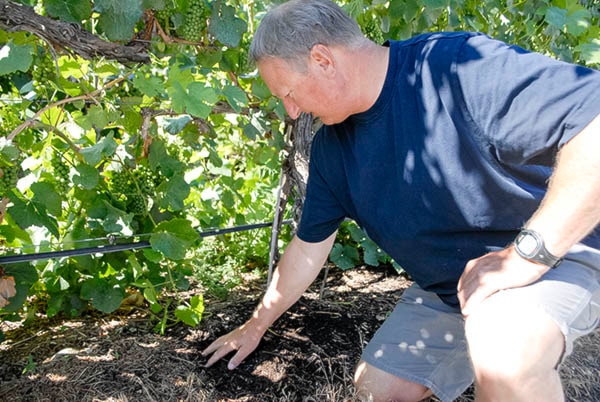Despite the headline attached to a press release from UBC Okanagan, vineyards aren’t degrading soil quality, at least according to local grape growers.
Tim Watts, who has operated Kettle Valley Winery on the Naramata Bench for 25 years, said the headline “UBC researchers determine vineyards adversely affect soil quality,” was misleading. When he received the interview request from the Western News, he was at a conference where Miranda Hart, one of the research team, was the next speaker.
The first thing Hart did as she took the podium, Watts said, was to apologize for the headline attached to her article. Hart, an associate professor and PhD candidate, spent three years studying vineyard soils along with Taylor Holland and Agriculture Canada research scientist Pat Bowen.
Planting anything, whether it’s a lawn, an orchard or a vineyard, changes the balance of microbes in the soil, Watts said.
Hart’s team looked at soils in vineyards and neighbouring natural—or uncultivated—habitats. With samples from both areas, the scientists compared the bacterial and fungal communities between habitats, and determined there was a definite difference in soil communities between the natural valley soil and that under the wine-producing grapes.
“Which is what you would expect,” said Watts, noting the BC Wine Grape Council was one of the funders of Hart’s research.
“This was a very first look at it. It was a great piece of research and it was an eye-opener for everybody, just because we don’t think about that sort of thing.”
Watts said growers usually focus on just the one or two bacteria or fungi they have problems with, trying to nudge those as little as possible. With the new research coming, he thinks growers will now start to look at the soil the same way.
Hart points out there is a limited understanding of how agriculture practices change soil biodiversity, it is important to understand what the soil would be like if left in its natural state, so growers are aware of how they may be changing it.
The samples they tested showed that bacterial and fungal communities responded differently to viticulture: bacteria had a higher biodiversity in vineyards, compared to fungi which had higher biodiversity in unmanaged areas.
Watt, a geologist as well as the co-proprietor and co-Winemaker at Kettle Valley has been growing grapes on the bench since 1986. He said the soil is probably better for growing grapes now, as the microbial culture in the soil adjusts to the plants growing in it.
Bryan Hardman, whose family has cultivated the same parcel of land in Naramata for nearly a century, also said he hasn’t seen adverse effects.
“There has no decrease in productivity over the decades and no degradation of the soil. If anything, production has increased wth modern farming methods,” said Hardman. “Grape production is one of the least invasive crops I know having commercially grown apples, pears, cherries, apricots, peaches and nursery trees.”
At the conference, Hart spoke to the growers about mycorrhizal fungi, a naturally-occurring fungi that colonizes the roots of the plant and sets up a symbiotic relationship. Growers intentionally introduce the fungi, which enhances growing conditions with the fine network of filaments it spreads through the soil.
“They are better at pulling water and nutrients out of small spaces. They deliver water and nutrients to the plant, the plant provides it with carbon,” said Watts.
Sometimes though, the fungus introduction doesn’t take, or becomes parasitic, not returning as much as it is taking from the plant. Hart asked why add this fungi and alter the balance in the soil if growers are not getting a substantial benefit out of it.
Watts said these are the kind of questions they want answered, so they can learn to grow better grapes more efficiently.
“Most of the work that is done is regarding how do we do a better job, with less effect on the environment This was right in line with that,” said Watts. “It is really good work, and that is the sort of thing we are after. That is why we fund it.
“We are happy with the article, it was the headline, it’s was a little bit misleading. It doesn’t even match the body of the text in the article.”
Bowen, who works at the Summerland research centre, said knowing what’s happening in the soil is a vital part of agriculture for several reasons.
“Microbial communities also play an important role in stabilizing vineyard ecosystems which can reduce the need for pesticides and other resource inputs,” Bowen said.
Along with the BC Wine Grape Council, Hart’s research was funded by an NSERC Discovery Grant and Agriculture and Agri-Food Canada and was recently published in Applied Soil Ecology.
